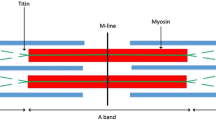Summary
-
1.
A comparative study of the contractile mechanism of frog’s, dog’s andMytilus muscles has been made.
-
1.
Sodium and potassium chlorides have identical action on the three kinds of muscles. Barium chloride and sodium cyanide cause contraction of the contractile mechanism of unstriated muscle ofMytilus and elongation of frog’s and dog’s muscle.
-
3.
Contraction of the contractile mechanism of unstriated muscle are of two kinds. One kind is relaxed by swelling of the muscle and the other kind not. Relation of this finding to the tonus mechanism is discussed.
-
4.
Action of ammonium, calcium, strontium, magnesium, bromide, nitrate, iodide and thiocyanate is described. Potassium, magnesium relax the contractile mechanism.
-
5.
The excitatory and the contractile mechanism of unstriated muscle have been dissociated by destroying the former by high voltages (110–880 volts A.C.) and by methyl alcohol. Action of substances on the contractile mechanism has then been studied.
-
6.
If normal tone of the muscle is destroyed, then the asphyxiai contraction does not occur, proving the identity of the two.
Similar content being viewed by others
References
Barer, R.J Anat., 1947,81, 259.
Rao, M. S. and Singh, I.J. Physiol., 1940,98, 12.
Katchalsky, A. and Eisenberg, H.Nature, 1950,166, 267.
Hill, A. V.Proc. Roy. Soc., 1949,136B, 399.
Singh, I.J. Physiol, 1938a,91, 398.
— —, 1938b,92, 62.
— —, 1938c,92, 232.
— —, 1938d,92, 241.
— —, 1939,96, 1.
—Proc. Ind. Acad. Sci., 1943a,17, 20.
— —, 1943b,17, 143.
— —, 1943c,28, 53.
—Nature, 1943d,152, 192.
—Proc. Ind. Acad. Sci., 1944,29, 91.
Singh, S. I. and Singh, I.Curr. Sci., 1947,16, 259.
—Proc. Ind. Acad. Sci., 1948a,27, 127.
—Curr. Sci., 1948b,17, 321.
—Proc. Ind. Acad. Sci., 1949a,30, 343.
— —, 1949b,30, 270.
— —, 1949c,30, 263.
— —, 1950a,31, 351.
— —, 1950b,32, 12.
—Curr. Sci., 1950c,19, 60.
Vorga, L.Hung. Acta. Physiol., 1946,1, 1. Quoted from Sandow, A.,Ann. Rev. Physiol., 1949,11, 297.
Author information
Authors and Affiliations
Additional information
An erratum to this article is available at http://dx.doi.org/10.1007/BF03050181.
Rights and permissions
About this article
Cite this article
Singh, S.I., Singh, I. A comparative study of the contractile mechanism of unstriated muscle. Proc. Indian Acad. Sci. 33, 165–177 (1951). https://doi.org/10.1007/BF03049993
Received:
Issue Date:
DOI: https://doi.org/10.1007/BF03049993




